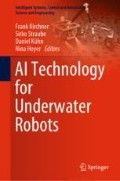Abstract
The work on modular and reconfigurable system design aims to improve the usability of underwater vehicles by broadening their versatility and adaptability to new situations and scenarios. This will be achieved by a modular system design on the hardware side and a reconfigurable software system. This is necessary since current design of underwater vehicles is usually tailor-made for a specific task or completely open-frame. While the latter option is more versatile, it is nearly exclusively found in ROV systems, since an open-frame design usually comes with limited hydrodynamic optimizations, requiring strong thrusters and thus a lot of energy which can only be supplied via thether. There are some AUV systems with a modular design, but these designs usually do not incorporate the modules in the vehicles control framework: Additional modules are independent from the main vehicle control and used only for data acquisition.
Access this chapter
Tax calculation will be finalised at checkout
Purchases are for personal use only
References
Arun C, Kenneth S, Ulrich K, R Drechsler (2015) Ensuring safety and reliability of IP-based system design—a container approach. In: Rapid system prototyping (RSP), 2015 international symposium on, pp 76–82. IEEE
Eickstedt DP, Sideleau SR (2009) The backseat control architecture for autonomous robotic vehicles: a case study with the iver2 auv. OCEANS 2009:1–8 Oct
Emmert J, Stroud C, Skaggs B, Abramovici M (2000) Dynamic fault tolerance in fpgas via partial reconfiguration. In: Field-programmable custom computing machines, 2000 IEEE symposium on, pp 165–174. IEEE
Hildebrandt M, Hilljegerdes J (2010) Design of a versatile AUV for high precision visual mapping and algorithm evaluation. In: Proceedings of the 2010 IEEE AUV monterey, Monterey
Luth C, Ring M, Drechsler R (2017) Towards a methodology for self-verification. In: 2017 6th international conference on reliability, Infocom technologies and optimization (Trends and Future Directions) (ICRITO), pp 11–15, Sept 2017
Noguera J, Kennedy IO (2007) Power reduction in network equipment through adaptive partial reconfiguration. In: Field programmable logic and applications, 2007. FPL 2007. international conference on, pp 240–245. IEEE
Paulsson K, Hübner M, Bayar S, Becker J (2007) Exploitation of run-time partial reconfiguration for dynamic power management in xilinx spartan III-based systems. In: International symposium on reconfigurable communication-centric systems-on-chip, pp 1–6
Sangekar M, Chitre M, Koay TB (2008) Hardware architecture for a modular autonomous underwater vehicle starfish. OCEANS 2008:1–8 Sept
Schmitz K, Chandrasekharan A, Gomes Filho J, Große D, Drechsler R (2017) Trust is good, control is better: Hardware-based instruction-replacement for reliable processor-ips. In: Design automation conference (ASP-DAC), 2017 22nd Asia and South Pacific, pp 57–62. IEEE
Schmitz K, Keszocze O, Schmidt J, Große D, Drechsler R (2018) Towards dynamic execution environment for system security protection against hardware flaws. In: 2018 IEEE computer society annual symposium on VLSI (ISVLSI), pp 557–562. IEEE
Trimberger S, Carberry D, Johnson A, Wong J (1997) A time-multiplexed fpga. In: Proceedings, the 5th annual IEEE symposium on Field-Programmable custom computing machines, pp 22–28. IEEE
Ustaoglu B, Huhn S, Große D, Drechsler R (2018) SAT-Lancer: a Hardware SAT-Solver for Self-Verification. In: 28th ACM great lakes symposium on VLSI (GLVLSI). o.A.
Author information
Authors and Affiliations
Corresponding author
Editor information
Editors and Affiliations
Rights and permissions
Copyright information
© 2020 Springer Nature Switzerland AG
About this chapter
Cite this chapter
Hildebrandt, M., Schmitz, K., Drechsler, R. (2020). Modular and Reconfigurable System Design for Underwater Vehicles. In: Kirchner, F., Straube, S., Kühn, D., Hoyer, N. (eds) AI Technology for Underwater Robots. Intelligent Systems, Control and Automation: Science and Engineering, vol 96. Springer, Cham. https://doi.org/10.1007/978-3-030-30683-0_5
Download citation
DOI: https://doi.org/10.1007/978-3-030-30683-0_5
Published:
Publisher Name: Springer, Cham
Print ISBN: 978-3-030-30682-3
Online ISBN: 978-3-030-30683-0
eBook Packages: Intelligent Technologies and RoboticsIntelligent Technologies and Robotics (R0)

